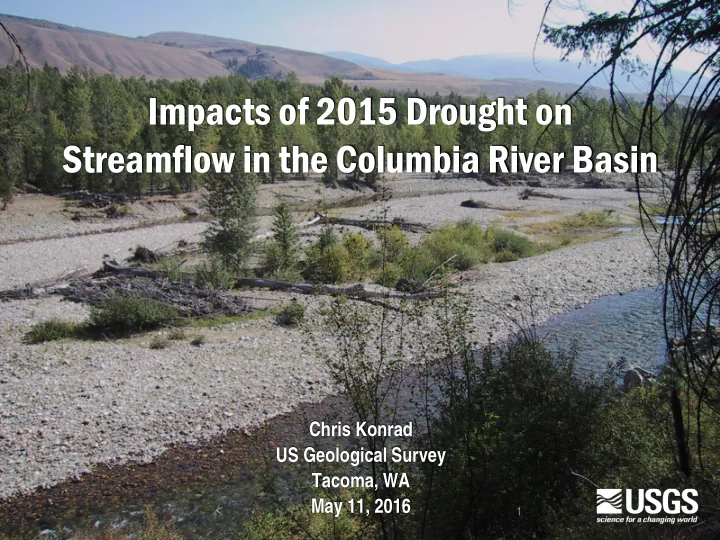

Impacts of 2015 Drought on Streamflow in the Columbia River Basin Chris Konrad US Geological Survey Tacoma, WA May 11, 2016 1 Provisional Information
Overview of USGS Investigation Western US had low snowpack, warm temperatures, and an extended summer dry period in 2015 USGS is investigating streamflow response in six western states Objectives • Document extent and severity of 2015 drought • Assess differences in sensitivity across systems in 2015 • Identify factors influencing vulnerability of particular systems to future droughts Provisional Information
Importance of Low Flow Streams that resist drought - high “unit-area” low flow, constant year-to-year - provide cold-water refugia for fish - priorities for habitat protection and connection. Streams that are vulnerable to drought - low unit-area low flow, variable year-to-year - priorities for water transactions - could be affected by groundwater withdrawals 3 Provisional Information
Analysis of Factors Affecting Low Flows Stream vulnerability to drought depends on precipitation, snow and ice melt, and groundwater. Ice melt and groundwater reduce vulnerability of streams to single-year drought. Primary question: what was the comparative influence of these factors on 2015 low flows at gaged sites? If the vulnerability of streams can be linked to specific factors, water managers will be able to forecast where water availability is likely to be an issue in a particular year. Provisional Information
Columbia River Basin Sites 434 USGS gages located in all of the major sub-basins and many watersheds Gaps in about half of the watersheds (0 or 1 gages for the watersheds in white) Low flow measurements Green shading indicates the during the summer of number of gages in each 8-digit HUC, which ranges from 0 to 12. 2015 at 340 ungaged sites Provisional Information
Streamflow in 2015 was below normal Westside with glacial Interior, high influence: elevation: rain-snow transitional snowmelt Median flow Interior, Westside, low-elevation: mid-elevation: rain-snow transitional snowmelt Westside, lower elevation rivers and streams generally had the most extreme low flows in 2015. Provisional Information Provisional Information
2015 Low Flows at USGS Gages in Columbia River Basin Median unit-area low flow ~0.15 cfs per sq mile (diagonal line) Only 4% higher for 184 “natural-flow” sites (blue shading) Variability in unit-area streamflow due to differences in precipitation and groundwater Provisional Information
Were Low Flows Extreme in 2015? Difference between extreme and normal low flow is small: 10 th percentile is typically 60% of the median (“2- year”) annual low flow or about 0.05 cfs/ sq mile. Low flows in 2015 were lower than normal in especially in Willamette, Lower Columbia, Spokane, and Upper Snake. Blue –above normal low flow Yellow –below normal low flow Orange – >0.05 cfs/sq mile below normal Provisional Information
Assessing Stream Vulnerability to Drought Median annual low flow provides a simple index of vulnerability. Provisional Information
Assessing Stream Vulnerability to Drought Median annual low flow provides a simple measure of stream vulnerability to drought. Measurements made from July through September were likely to be within 0.2 cfs/sq mile of 2015 low flow. 2.0 Difference between daily and minimum 1.5 cfs/sq mile streamflow for 95 th 1.0 and 50 th percentiles of gages. 0.5 2015 measurement window 0.0 Jul Aug Sep Provisional Information
Next Steps Products from initial analysis (2016) Assessment of stream-specific vulnerability to drought Method for estimating low flows from single measurements Possible tasks for the future 1. Expand the assessment of stream vulnerability to ungaged sites; 2. Basin-wide mapping of stream vulnerability 3. Assess groundwater recharge from snowmelt in rivers and its significance for base flow and water supply during droughts r 4. Incorporate stream-specific vulnerability into drought forecasting Provisional Information
Summary Streamflow was below in normal in the Columbia River Basin during the summer of 2015 particularly because of the lack of snowmelt. Low flows were exceptionally low in some streams (westside, low elevation) but were close to normal in many streams. Past response of streams is a good indicator of their vulnerability to drought. There is value to having even one low flow measurement. Provisional Information
Recommend
More recommend